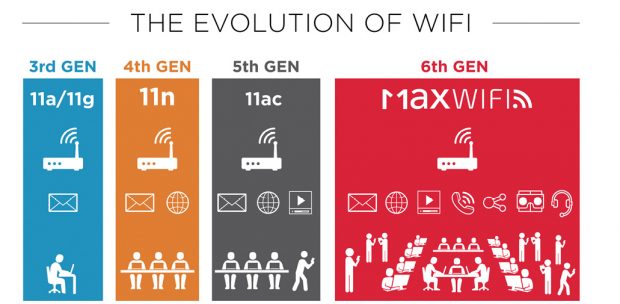The IoT Reshapes Wireless Network Design
Latest News
June 1, 2018
The rise of the internet of things (IoT) has forced engineers to rethink how they design wireless networks. The sheer number of mobile, wearable and other IoT devices joining the internet has caused developers to shift their focus to metrics like capacity and airtime utilization. Add this influx of client devices to the rich assortment of communication modes expected by businesses and consumers alike, and you have a Rubik’s Cube with which network planners must wrestle to keep up with the overwhelming demand of the IoT.
The fact is that capacity planning involves more than sustaining the highest data rate between wireless devices and access points (APs). Today’s networks must be able to accommodate a broad spectrum of data transfer requirements, ranging from the small, intermittent payloads of smart home appliances to the large, continuous data transmissions of real-time video surveillance systems.
At the same time, the designs must also support operational ranges that vary from feet for wearables to kilometers for automation monitoring and control. And networks have to be able to include devices sustained by energy sources ranging from button cells to mainline power supplies.
This inevitably raises the question: Is there a single wireless technology that can support all these variations in a capacity-based network design?
Wi-Fi’s Role
In the near term, most network technology providers believe the answer to that question is yes—sort of. They see Wi-Fi as the primary wireless technology for IoT devices. But as endpoint density increases and more precise location data is needed, other technologies will begin to assume greater roles.“Wi-Fi will continue to be a dominant near-term wireless technology for IoT in IT,” says Dennis Huang, director of enterprise wireless product marketing for Ruckus Networks. “But as IoT usage reaches further into environments that are difficult to connect and power, other wireless technologies—like BLE, Zigbee and other 802.15.4-based standards—will become more important. Wi-Fi continues to be the preferred option when a wireless device has access to the power grid, but when tethered power is unavailable or expensive, alternative wireless technologies will be essential.”
Wi-Fi’s strength arises from its established place in the wireless infrastructure. The 802.11ac and 802.11n standards already provide near ubiquitous in-building coverage. It also offers speed, ease of implementation, cross-vendor interoperability, low cost, reliability and the ability to handle large data transfers
 The materialization of the internet of things has caused network planners to gravitate toward capacity-based design approaches to accommodate the rapid proliferation of wireless devices. Within this context, network capacity encompasses diverse throughput, range and energy requirements, as well as packet-transmission and channel-use efficiency. Image courtesy of MaxWiFi.org.
The materialization of the internet of things has caused network planners to gravitate toward capacity-based design approaches to accommodate the rapid proliferation of wireless devices. Within this context, network capacity encompasses diverse throughput, range and energy requirements, as well as packet-transmission and channel-use efficiency. Image courtesy of MaxWiFi.org.Another factor in Wi-Fi’s favor lies in the fact that it will play an integral part in 5G cellular networks. “A lot of the 5G cellular traffic demand will likely be offloaded via Max WiFi or other 802.11ax installations using Wi-Fi’s existing dense and ubiquitous installed base to reduce the telecom carrier’s overall capital expenditure,” says Nitin Madan, marketing manager for Broadcom. “Wi-Fi is already the most heavily used internet connection technology, moving more than half of all internet traffic and 80% of all wireless traffic. Already, it’s critical to many cellular networks, which rely on Wi-Fi’s existence in end-user devices.”
 In the evolution of Wi-Fi, the standard’s authors have tried to add features that will enable the technology to meet emerging networking demands. The latest generation of Wi-Fi—802.11ax, or Max WiFi—attempts to accommodate transmission speed, stream efficiency and energy requirements of the internet of things. Image courtesy of MaxWiFi.org.
In the evolution of Wi-Fi, the standard’s authors have tried to add features that will enable the technology to meet emerging networking demands. The latest generation of Wi-Fi—802.11ax, or Max WiFi—attempts to accommodate transmission speed, stream efficiency and energy requirements of the internet of things. Image courtesy of MaxWiFi.org.That said, standard Wi-Fi does have shortcomings that inhibit its use in certain IoT applications.
Designing for Capacity
Early Wi-Fi networks were built for basic connectivity and low-data applications. But with the emergence of the IoT, the market has experienced a sea change in usage patterns. The Institute of Electrical and Electronics Engineers (IEEE) anticipates that there will be 50 billion connected wireless devices by 2022. With so many devices populating the network, designers have had to adopt a capacity-based network design approach, a technique tailored to manage densely populated environments, increased data traffic and a diverse mix of applications.Deploying for capacity rather than just coverage requires changes in the network’s basic structure and adoption of specialized management technologies. One option involves increasing the number of deployed APs and their proximity to each other.
Client throughput is but one facet of capacity-based networks. “Capacity planning is not only about sustaining the highest MCS [modulation schemes and coding] rate connection between a device and the AP for all the devices on the network,” says Huang. “It is also about how the network moves that packet over the air.”
Making changes to the network’s architecture opens the door for improved performance, but it also brings its own brand of challenges; this is where specialized management technologies come into play.
Mitigating Interference
One of the biggest challenges encountered by network designers is co-channel interference (CCI). Adding access points to improve network capacity can exacerbate CCI. To counter this problem, designers can benefit from a number of wireless technologies and techniques.A key component to reduce CCI is the move to 5 GHz with 802.11ac, which alleviates traffic congestion in the 2.4 GHz band and helps reduce interference issues. As valuable as this approach is, it still is not enough.
“Mitigating co-channel interference will require a good channel-reuse plan, including defining appropriate channel widths on 5 GHz,” says Bryan Harkins, training and enablement manager for Ekahau. “Capacity-based designs in general will require increasing the density of APs, compared with coverage-based designs. Because of this, AP placement will be key for breaking up collision domains into smaller pieces while providing more airtime.”
 The growing complexity of Wi-Fi networks requires that site survey tools provide designers with a thorough understanding of the deployment environment. Shown at the top of the screen, Ekahau’s Site Survey Pro depicts a map, with simulated access points and their predicted signal strength. At the bottom, the troubleshooting tool visualizes narrowband interference impacting multiple Wi-Fi channels. Image courtesy of Ekahau.
The growing complexity of Wi-Fi networks requires that site survey tools provide designers with a thorough understanding of the deployment environment. Shown at the top of the screen, Ekahau’s Site Survey Pro depicts a map, with simulated access points and their predicted signal strength. At the bottom, the troubleshooting tool visualizes narrowband interference impacting multiple Wi-Fi channels. Image courtesy of Ekahau.In addition to channel-reuse planning, designers must load-balance clients between APs, bands and radios. Traffic must be load-balanced by media type to prioritize latency-sensitive voice and video. Load balancing allows the network to distribute client demands across all APs, maximizing the available spectrum within the coverage area and enhancing spectral efficiency.
Another technique is band steering, which leverages the capacity to communicate over both the 2.4 GHz and 5 GHz bands. If the client is dual-band capable, band steering directs the client to connect with the less congested 5 GHz network by actively blocking the client’s attempts to associate with the 2.4 GHz network. This provides greater capacity and reduces co-channel interference.
Making Wi-Fi IoT-Friendly
Although contemporary Wi-Fi standards—802.11 ac and 802.11n—have supported wireless network designers well in the past, the technologies struggle to meet the capacity demands of the IoT. But the latest version—802.11ax, or high-efficiency wireless—aims to eliminate the shortfalls, improving performance, expanding coverage and extending client battery life.The authors of 802.11ax have tailored the technology to meet the specific demands of the IoT. Thanks to a complete redesign of the standard, 802.11ax promises to provide as much as six times faster speeds, four times greater range and seven times longer battery life.
One of the technologies enabling this, orthogonal frequency-division multiple access (OFDMA), allows 802.11ax to handle data traffic much more efficiently. Instead of using an entire channel to transmit one client’s data while another client’s data waits for “their turn,” 802.11ax schedules traffic so that each device’s data gets enough airtime and concurrently transmitted bandwidth.
 Orthogonal frequency-division multiple access (OFDMA) allows 802.11ax to more efficiently handle data traffic. It achieves this by separating individual channels into subchannels, each with a different frequency. Rather than have devices wait until the entire channel is free before they transmit data, the devices can use the subchannels to simultaneously transmit data using the same channel. Image courtesy of MaxWiFi.org.
Orthogonal frequency-division multiple access (OFDMA) allows 802.11ax to more efficiently handle data traffic. It achieves this by separating individual channels into subchannels, each with a different frequency. Rather than have devices wait until the entire channel is free before they transmit data, the devices can use the subchannels to simultaneously transmit data using the same channel. Image courtesy of MaxWiFi.org.OFDMA achieves this by separating individual channels of the spectrum into many smaller subchannels, each with a slightly different frequency. So rather than queuing to transmit data using the entire frequency band, multiple devices can simultaneously share a channel. OFDMA further enhances capacity by allocating devices only enough of the spectrum to meet their needs.
In addition to OFDMA, 802.11ax incorporates BSS Coloring, a feature that increases capacity in dense environments. In situations where you have multiple, overlapping Wi-Fi networks, average network throughput degrades due to the “historical politeness” of Wi-Fi protocol—technically called CSMA/CA. This feature prevents collisions by waiting until the channel is completely clear before transferring a packet. As a result, only one packet can be sent at a time. With BSS Coloring, you can have multiple conversations at the same time, increasing the average data rate.
The 802.11ax standard also addresses concerns about Wi-Fi energy consumption with a technology called target wake time (TWT). This feature enables phones and other devices to turn off their radios when they are not exchanging data, improving efficiency and battery life.
All these features represent significant advances in network performance and energy efficiency, but the standard will not have an immediate impact on the IoT. The Wi-Fi Alliance doesn’t expect to see mass adoption of 802.11ax until 2019, when product certification begins. The certification process ensures that all Wi-Fi products work together as they’re supposed to. In the meantime, companies can and will introduce Wi-Fi products before certification, but most will wait for the standard to be finalized.
In addition to the delay caused by the standard-making process, basic market forces may push availability back even further. “The rollout of newer technologies, such as 802.11ax, will be delayed,” says Harkins. “Replacing existing client devices that are working is going to be a slow go. Companies do not replace all the clients as soon as the standard adds amendments and APs start shipping. APs are replaced every five years or so. Client devices will take longer to be developed and longer to be adopted in the enterprise. It is not like flipping on a switch when new ideas arise.”
Design Tools and Automation
It’s one thing to talk about how the IoT has triggered changes in design concepts, techniques and strategies. But how has the change affected the basic tools of network design?The answer is that as designers build more complex networks, they need the clearest possible picture of the environment in which the network will function. As a result, tools that used to be luxuries have become essential.
“The need for well done, complete surveys has been increasing since the early 2000s,” says Harkins. “As the volume of wireless client devices grows, this will only become more important. Being able to control the size of your contention domains, channel use and coverage shape will all rely upon solid designs. This is achievable only when analyzing both layer one and layer two in pre-deployment physical surveys is done professionally.”
This requires spectrum analysis in all frequencies used by Wi-Fi to identify noise sources that must be avoided in your design. It includes heat maps that allow the user to visualize different aspects of the RF environment. And it means being able to see where troubles reside to better design the network to work in that space.
Another factor designers must keep in mind is that the one constant in a network is change. As a result of this and the growing complexity of networks, technology providers have been increasing the amount of automation enabled in their systems.
“A thorough understanding of the deployment environment is essential for planning Wi-Fi access point placement and settings, but you have to assume that no deployment will be static,” says Mike Tennefoss, vice president of strategic partnerships for Aruba Networks. “So it’s equally important that the Wi-Fi network dynamically adapt to a changing environment without manual intervention except in extraordinary circumstances—such as a wall was moved or an access point was damaged.”
Stopgap Measures
As a result of the delayed impact of 802.11ax, legacy devices will populate the network for years. These devices will not support OFDMA or TWT. How can designers make the most of advances with a mixture of old and new systems?The answer is a hybrid approach that buys time until 802.1ax achieves broad adoption. “We recommend that one must segregate legacy devices on a separate channel than the newer 802.11ax devices to obtain the full benefit of the new technology, such as higher battery life and reduced airtime consumption,” says Madan. “Additionally, it is important to consider complementary technologies, such as MBO [multi-band operations] and OCE [optimized connectivity experience], in deployment scenarios to optimize the user experience.”
The MBO and OCE initiatives aim to provide a robust, interoperable client-steering mechanism that allows a client to share information with the AP about its capabilities, connection choices and migration options. This enables better AP steering decisions that consider the client’s perspective.
Embracing Diversity
Wi-Fi already plays a key role in cellular network connectivity. Companies like Cisco, Samsung and Mojo Networks offer Wi-Fi APs that serve as gateways for the IoT, supporting combinations of already established technologies.Wi-Fi will play a major role in the IoT, as the network grows and technology changes. But as the web of connectivity evolves, technologies like BLE, ZigBee and 5G will take on specialized functions, playing to their unique strengths.
More Info
Aruba NetworksSubscribe to our FREE magazine, FREE email newsletters or both!
Latest News






